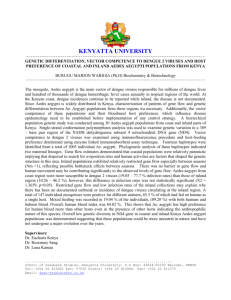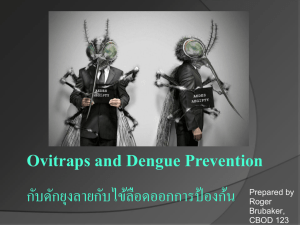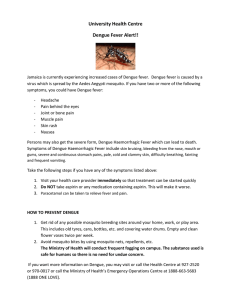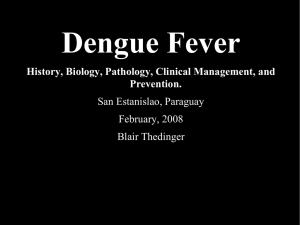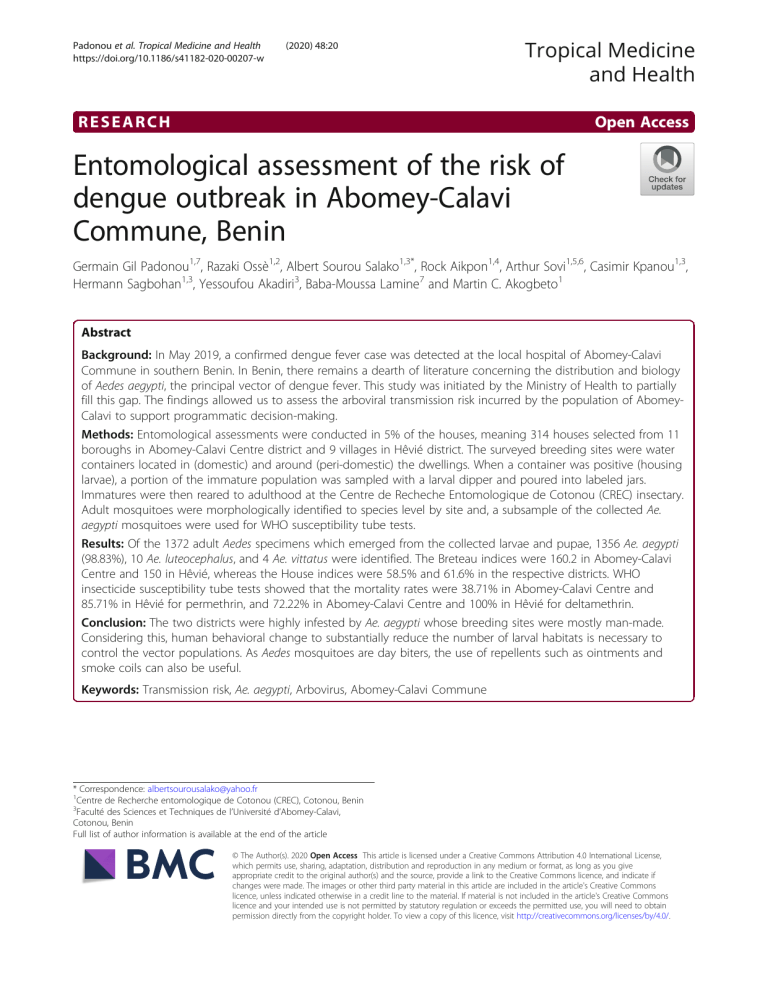
Padonou et al. Tropical Medicine and Health https://doi.org/10.1186/s41182-020-00207-w (2020) 48:20 Tropical Medicine and Health RESEARCH Open Access Entomological assessment of the risk of dengue outbreak in Abomey-Calavi Commune, Benin Germain Gil Padonou1,7, Razaki Ossè1,2, Albert Sourou Salako1,3*, Rock Aikpon1,4, Arthur Sovi1,5,6, Casimir Kpanou1,3, Hermann Sagbohan1,3, Yessoufou Akadiri3, Baba-Moussa Lamine7 and Martin C. Akogbeto1 Abstract Background: In May 2019, a confirmed dengue fever case was detected at the local hospital of Abomey-Calavi Commune in southern Benin. In Benin, there remains a dearth of literature concerning the distribution and biology of Aedes aegypti, the principal vector of dengue fever. This study was initiated by the Ministry of Health to partially fill this gap. The findings allowed us to assess the arboviral transmission risk incurred by the population of AbomeyCalavi to support programmatic decision-making. Methods: Entomological assessments were conducted in 5% of the houses, meaning 314 houses selected from 11 boroughs in Abomey-Calavi Centre district and 9 villages in Hêvié district. The surveyed breeding sites were water containers located in (domestic) and around (peri-domestic) the dwellings. When a container was positive (housing larvae), a portion of the immature population was sampled with a larval dipper and poured into labeled jars. Immatures were then reared to adulthood at the Centre de Recheche Entomologique de Cotonou (CREC) insectary. Adult mosquitoes were morphologically identified to species level by site and, a subsample of the collected Ae. aegypti mosquitoes were used for WHO susceptibility tube tests. Results: Of the 1372 adult Aedes specimens which emerged from the collected larvae and pupae, 1356 Ae. aegypti (98.83%), 10 Ae. luteocephalus, and 4 Ae. vittatus were identified. The Breteau indices were 160.2 in Abomey-Calavi Centre and 150 in Hêvié, whereas the House indices were 58.5% and 61.6% in the respective districts. WHO insecticide susceptibility tube tests showed that the mortality rates were 38.71% in Abomey-Calavi Centre and 85.71% in Hêvié for permethrin, and 72.22% in Abomey-Calavi Centre and 100% in Hêvié for deltamethrin. Conclusion: The two districts were highly infested by Ae. aegypti whose breeding sites were mostly man-made. Considering this, human behavioral change to substantially reduce the number of larval habitats is necessary to control the vector populations. As Aedes mosquitoes are day biters, the use of repellents such as ointments and smoke coils can also be useful. Keywords: Transmission risk, Ae. aegypti, Arbovirus, Abomey-Calavi Commune * Correspondence: albertsourousalako@yahoo.fr 1 Centre de Recherche entomologique de Cotonou (CREC), Cotonou, Benin 3 Faculté des Sciences et Techniques de l’Université d’Abomey-Calavi, Cotonou, Benin Full list of author information is available at the end of the article © The Author(s). 2020 Open Access This article is licensed under a Creative Commons Attribution 4.0 International License, which permits use, sharing, adaptation, distribution and reproduction in any medium or format, as long as you give appropriate credit to the original author(s) and the source, provide a link to the Creative Commons licence, and indicate if changes were made. The images or other third party material in this article are included in the article's Creative Commons licence, unless indicated otherwise in a credit line to the material. If material is not included in the article's Creative Commons licence and your intended use is not permitted by statutory regulation or exceeds the permitted use, you will need to obtain permission directly from the copyright holder. To view a copy of this licence, visit http://creativecommons.org/licenses/by/4.0/. Padonou et al. Tropical Medicine and Health (2020) 48:20 Background In recent years, Africa has experienced a number of urban arboviral disease epidemics such as yellow fever and dengue fever. Despite the availability of an effective vaccine, the yellow fever virus is still present in the continent. In 2016, an epidemic of yellow fever occurred in Angola and the Democratic Republic of Congo [1]. Moreover, in West African countries, the presence of all four serotypes of the virus responsible for dengue fever (DENV-1, DENV-2, DENV-3, and DENV-4) has been documented [2, 3]. In Benin, between July and August 2010, two cases of dengue fever were diagnosed in travelers returning from Cotonou to France [4, 5]. In May 2019, a suspected case of viral hemorrhagic fever was detected at the local hospital of Abomey-Calavi Commune. This patient resided in the borough of Tankpè in Abomey-Calavi Centre. Blood sample analysis confirmed the presence of dengue fever with a high viremia [6]. The proliferation of mosquitoes carrying arboviruses is likely due to a number of factors including the following: demographic growth, increased population mobility/connectivity, suboptimal water storage practices, and poor management of potential larval habitats such as discarded tires and car bodies in recent years. Indeed, when these conditions are met, disease transmission could occur rapidly following the arrival of an infected traveler. In such circumstances, disease management would prove challenging given that Benin has never before experienced a dengue epidemic and that its manifestations could easily be confused with malaria. Unlike in Asia, America, and Europe, dengue fever is very poorly documented in Africa, particularly in the western part. The principal vector of this disease (Aedes aegypti), which is present in Benin [7], is proliferating globally due to the development of trade exchanges, the speed of transport, and the high frequency of international travel. In Benin, there remains a dearth of literature on the distribution and biology of Ae. aegypti, and information on the burden of the diseases transmitted by this vector is limited to reported cases. This situation handicaps the implementation of targeted actions aimed at effectively controlling the vector. This cross-sectional study was initiated by the Benin’s Ministry of Health through the Center for Research in Entomology of Cotonou (CREC), to partially fill this gap. The findings enabled the assessment of the arboviral transmission risk incurred by the population of AbomeyCalavi to support programmatic decision-making. Methods Study area The study was carried out in the Abomey-Calavi Commune, southern Benin. The commune covers an area of 539 km2, representing 0.48% of the country’s national Page 2 of 9 surface area. It has a slightly rugged relief. The climate is sub-equatorial with two rainy seasons and two dry seasons. The hydrographic network is essentially made of two water bodies, Lake Nokoué and the coastal lagoon. There are 1,374,026 inhabitants from 254,024 households in seventy villages and boroughs [8]. Data collection was carried out in two districts, Abomey-Calavi Centre and Hêvié, due to their high population density. The district of Abomey-Calavi Centre was selected as it shelters Tankpè, the area from where the dengue case was reported. Among the 20 boroughs of the Abomey-Calavi Centre district, the 11 most populated and in closest proximity to Tankpè, whose leaders agreed to participate in the study, were surveyed. The Hêvié district comprises 9 villages, all of which were surveyed in the present study (Fig. 1). House sampling techniques for larvae collection in domestic and peri-domestic breeding sites Based on data from the Institut National de la Statistique et de l’Analyse Economique [8], a sample of 5% of houses was selected, equating to 314 houses in the 2 targeted districts. On average, 16 and 15.33 houses per village/boroughs were selected in the Abomey-Calavi Centre and Hêvié districts respectively. The surveyed houses were randomly selected from the lists of houses available within the zone hospital of each district. Contact with house occupants and consent We accessed each targeted house with the help of a guide from the village who was fluent in the local language. Before collecting the larvae in and around a house, the team greeted the occupants, introduced themselves, asked about the householder, and explained the objectives of the activity and how the larvae collection is conducted. The usefulness of the data collected during the survey in taking preventive measures against dengue fever was also clarified. The team then sought the oral consent of each householder or his representative to inspect all containers, and access their living and bath rooms, in the company of one household occupant. The team also collected information regarding the number of sleeping areas and the total number of people in the house. Procedure of larvae collection from domestic and peridomestic breeding sites In each village/borough, the larval collection team was composed of two CREC staff members and a guide appointed by the chief of village. The survey consisted of surveying water containers for presence (positive containers) or absence (negative containers) of Aedes larvae inside (domestic breeding sites) and around houses at a distance of 3–5 m (peri-domestic breeding sites). The Padonou et al. Tropical Medicine and Health (2020) 48:20 Page 3 of 9 Fig. 1 Map of the study area inspection of the containers began indoors and the larvae were collected using a larval dipper and a flashlight. The house’s GIS coordinates were recorded using a GPS (eTrex Legend® H/Garmin). For positive containers, a portion of the immature population was collected and labeled according to the date, house number, and village/borough name. Thereafter, the breeding sites as well as, the remaining immature population were destroyed. The container types were classified as follows: - Domestic containers: buckets, earthen jars, barrels, drums, cans (bottles, plastics), flower pots, water tanks - Tires - Discarded containers: plastic bags, cans - Natural containers: coconut, fruit shell, tree hollows, sheathing plants (leaves, flowers) - Other: abandoned cars, mortars, wheelbarrows The collected larvae were transferred to vials and transported to the CREC insectary for rearing until adulthood mosquitoes. The adult mosquitoes were Padonou et al. Tropical Medicine and Health (2020) 48:20 morphologically identified to species level using the taxonomic keys of Edwards [9] and Yiau-Min [10]. Insecticide susceptibility tests Adult Ae. aegypti mosquitoes were tested against permethrin (0.75%) and deltamethrin (0.05%) to determine their susceptibility level, using the World Health Organization (WHO) tube tests. The exposure time of mosquitoes to insecticide-treated papers was 1 h. The resistance status of the mosquitoes was determined according to the WHO criteria [11]. Evaluated parameters and data analysis Entomological surveillance indicators [12] were calculated from positive breeding sites. The following Stegomyia indices were used [13, 14]: Container Index (CI): number of containers with water infested by Aedes larvae or pupae × 100∕number of inspected containers. This index is interpreted using the following ranges: - If CI < 3, the risk of an epidemic is low; - If 3 ≤ CI ≤ 20, the risk is moderate; - If CI > 20, the epidemic risk is high. Breteau Index (BI): number of positive containers found in 100 surveyed houses. This index is interpreted as follows: - If BI <5, the risk of an epidemic is low; - If 5 ≤ BI ≤50, the risk is moderate; - If BI > 50, the epidemic is likely to occur when the virus is present and the proportion of receptive individuals in the human population is high. House Index (HI): number of positive houses × 100∕number of visited houses. The following ranges are used to interpret this index: - If HI < 4, the risk of an epidemic is low; - If 4 ≤ HI ≤ 35, the risk of an epidemic is moderate; - If HI > 35, the risk of an epidemic is high. The different ranges mentioned above to interpret the three evaluated indices were defined by WHO [15]. R version 3.5.1 [16] was used for data analysis. A comparison of Breteau Index of villages/boroughs was made, using the rate 2 by 2 test (epitools package). A comparison of Container Index and House Index of villages/boroughs was made, using the chi-squared multiple proportion test. The same test was used to compare the proportions of the breeding site types (infested and noninfested) inside and outside houses in each district. Results Page 4 of 9 of 5 for the Breteau Index, 3% for the Container Index, and 4% for the House Index. In all villages/boroughs, the indices were higher than these values, indicating there is high epidemic risk (Table 1). By considering the House Index, the highly infested boroughs in the AbomeyCalavi Centre district were Tankpe (87.5%), Tchinangbegbo (87.5%), and Gbodjo (81.3%), while according to the Breteau Index, the highly infested boroughs were Tokpazoungo (337.5) and Agori (293.8). In Hêvié district, Akossavie (80%) and Hounyeva (71.4%) were at highest epidemic risk when considering the House Index, whereas Akossavie (220) and Hounzevie (262.5) were at highest epidemic risk according to the Breteau Index. Similarly, the situation remains alarming at the district level. In both districts, the Breteau Index (160.2 in Abomey-Calavi Centre and 150 in Hêvié) and the House Index (58.5% in Abomey-Calavi Centre and 61.6% in Hêvié) show a very high risk of epidemic (Table 1). In contrast, the Container Index (19.6% in Abomey- Table 1 Breteau, Container, and House indices in AbomeyCalavi Centre and Hêvié districts Nhi Npi Tc Npc BI CI HI Abomey-Calavi Centre 176 103 1436 282 160.2 19.6 58.5 Aganmadin 16 8 92 15 93.8a 16.3a 50.0a Agori 16 11 424 47 293.8b 11.1a 68.8a c a 29.4a Aifa 17 5 52 5 29.4 9.6 Aitchedji 17 9 84 23 135.3a 27.4a 52.9a a b CiteLesPalmiers 15 7 31 15 100.0 48.4 46.7a Fandji 16 8 109 20 125.0a 18.3a 50.0a a a Gbodjo 16 13 273 28 175.0 10.3 81.3a Seme 15 4 101 13 86.7a 12.9a 26.7a b 87.5a a Tankpe 16 14 70 26 162.5 37.1 Tchinangbegbo 16 14 53 36 225.0a 67.9b 87.5a 54 e 337.5 36.7b 62.5a Tokpazoungo 16 10 147 Hêvié 138 85 1252 207 150.0 16.5 61.6 Adovie 15 10 206 26 173.3a 12.6a 66.7a Akossavie 15 12 163 33 220.0a 20.2b 80.0a a Dossounou 15 10 121 25 166.7 20.7b 66.7a HevieCentre 15 6 283 10 66.7b 3.5c b 40.0a a 12.9 47.1a Houinme 17 8 101 13 76.5 Hounyeva 14 10 137 20 142.9a 14.6a 71.4a a d Hounzevie 16 11 72 42 262.5 58.3 68.8a Sogan 15 10 126 20 133.3a 15.9a 66.7a 18 a 112.5 d 41.9 50.0a 155.7 18.2 59.9 Entomological surveillance indices Zoungo 16 8 43 Of a total of 314 houses surveyed, 176 were in AbomeyCalavi Centre and 138 in Hêvié. According to the World Health Organization, there is a risk of epidemic when entomological surveillance indices exceed the threshold Grand total 314 188 2688 489 Nhi number of surveyed houses, Npi number of positive houses, Tc total containers, Npc number of positive containers, BI Breteau Index, CI (%) Container Index, HI House Index (%). For a same parameter of the table, the gap between values with different superscripts is significant (p < 0. 05) Padonou et al. Tropical Medicine and Health (2020) 48:20 Calavi Centre and 16.5% in Hêvié) indicates a medium risk. Type of breeding sites Figures 2 and 3 show the proportion of each type of potential breeding site and, the percentage of those that are positive for Aedes larvae inside and outside the houses in Abomey-Calavi Centre and Hêvié districts respectively. In Abomey-Calavi Centre, the predominant breeding sites were domestic containers both indoors (90.5%) and outdoors (57.6%) (Fig. 2). They included buckets, jars, barrels, drums, cans (bottles, various plastic bowls), flower pots, cisterns, and water troughs. Around the houses, other types of containers such as plastic bags, natural containers (tree hollows, sheathing plants: leaves, flowers, fruit shells), abandoned car bodies, abandoned wheelbarrows, and abandoned mortars were found. Overall, natural breeding sites were minor both outdoors (18%) and indoors (0.4%). Tires were in a low proportion indoors (3.8%) and outdoors (14.4%). Moreover, domestic containers (82.5% indoors and 61.6% outdoors) as well as tires (15% indoors and 28.1% outdoors) were the most infested with Aedes larvae. In Hêvié, types, locations, and larval infestation rates of breeding sites were similar to those observed in Abomey-Calavi Centre. However, the proportion of natural breeding sites located indoors was significantly Page 5 of 9 higher in Abomey-Calavi Centre (16.9%) compared to Hêvié (0.4%, p < 0.0001). Conversely, the proportion of natural breeding sites situated outdoors was significantly higher in Hêvié (35.7%) than in Abomey-Calavi Centre (18%, p < 0.0001). Moreover, the proportion of indoor infested domestic containers were 82.5% in AbomeyCalavi Centre relative to 67.4% (p < 0.0001) in Hêvié whereas, outdoor infested domestic containers were of 61.6% in Abomey-Calavi Centre against 61.5% (p < 0.0001) in Hêvié. Most of the breeding sites which were favorable to the development of Aedes, were man-made. Number and species of Aedes collected per borough or village Of the 1372 specimens of Aedes which emerged from collected larvae and pupae (Table 2), 1358 Ae. aegypti (98.97%), 10 Ae. luteocephalus, and 4 Ae. vittatus were identified. Ae. aegypti was found in both Abomey-Calavi Centre and Hêvié districts, while Ae. luteocephalus and Ae. vittatus were only observed in Abomey-Calavi Centre (Table 2). The most productive boroughs in Abomey-Calavi Centre in terms of Ae. aegypti vectors were Gbodjo and Tankpè (Table 2). In the Hêvié district, the most productive villages for the same mosquito were Dossounou, Akossavie, Sogan, Hounzevie, and Hounyeva. Fig. 2 Proportion of potential and positive of breeding site types located indoors and outdoors in Abomey-CalaviFor a same parameter, parts of a same circle diagram with values holding different superscripts are significantly different (p < 0.05) Padonou et al. Tropical Medicine and Health (2020) 48:20 Page 6 of 9 Fig. 3 Proportion of potential and positive of breeding site types located indoors and outdoors in HêviéFor a same parameter, parts of a same circle diagram with values holding different superscripts are significantly different (p < 0.05) Susceptibility of Aedes aegypti to insecticides Mortality rates of Ae. aegypti from Abomey-Calavi Centre following exposure to permethrin and deltamethrin in WHO susceptibility tube tests were 38.71% (24/ 62) and 72.2% (52/72) respectively. In contrast, mortality observed with Ae. aegypti collected from Hêvié following exposure to permethrin and deltamethrin was 85.71% (72/84) and 100% (96/96) respectively (Table 3). These results indicate presence of resistance of Ae. aegypti to the two tested pyrethroids in Abomey-Calavi Centre. Meanwhile, full susceptibility to deltamethrin, as well as resistance to permethrin was observed in Hêvié. Discussion Dengue fever, whose distribution was formerly constrained to Latin America and Asia, has now spread to West Africa [17–19], with Ae. aegypti believed to be primarily responsible for its transmission [20]. The present study provides an update on the arboviral transmission risk incurred by the population of Abomey-Calavi Commune to support interventional decision-making. In Abomey-Calavi Centre and Hêvié districts where this study was carried out, Ae. aegypti larvae were collected from several houses. According to the classical thresholds, a high risk of epidemic is declared when the Breteau Index exceeds 5, the Container Index exceeds 3, and the House Index exceeds 4. However, dengue epidemics can occur even with lower values of these indices [15]. In the present study, much higher infestation rate compared to the threshold values was found, indicating high epidemic risk. This was due to the high density of Ae. aegypti vectors and confirms previous work that has reported its strong presence in southern Benin [21]. The high House Index rates in Tankpe (87.5%), Tchinangbegbo (87.5%), and Gbodjo (81.3%) in Abomey-Calavi Centre may be due to the long water storage in domestic containers, which favored the laying of Ae. aegypti eggs. However, by considering the Breteau Index, the most infested boroughs were Tokpazoungo (337.5) and Agori (293.8) in the Abomey-Calavi Centre district. This means that determination of indices as epidemiological surveillance indicators [13, 14, 22] raises interpretation issues as previously stated by Mouchet [23]. The issue of interpretation already appears in the definition of the word “house,” whose features and dimensions are highly variable in African societies. The difficulty in defining the word “house” and therefore the terms “domestic and peri-domestic breeding sites” could justify why it is complex to interpret the variation in epidemiological risk levels according to the type of index used (House Index, Container Index, or Breteau Index). Nevertheless, the findings of this study clearly demonstrate that dengue transmission risk is high in both districts regardless of the index type used to determine the risk level. In other communes in West Africa such as Cocody and Bingerville in Côte d’Ivoire, Padonou et al. Tropical Medicine and Health (2020) 48:20 Page 7 of 9 Table 2 Aedes species and number of adult individuals by borough/village Number of individuals Total District Boroughs/villages Aedes aegypti Aedes luteocephalus Aedes vittatus Abomey-Calavi Centre Aifa 36 – – Seme 34 – – Tankpe 96 – – Aitchedji 38 – – Fandji 66 – 4 Cite palmiers 82 8 – Tokpa zoungo 80 – – Agamadin 40 – – Agori 50 – – Gbodjo 98 2 – Tchinagbegbo 64 – – Total 684 10 4 Dossounou 126 – – Hevie centre 36 – – Zoungo 38 – – Adovie 54 – – Akossavie 104 – – Sogan 100 – – Houinme 4 – – Hounzevie 110 – – Hounyeva 102 – – Total 674 – – 674 Grand total 1358 10 4 1372 Hêvié 698 In each district, villages/boroughs with different superscript are significantly different (p > 0.05) high values of Breteau Index (297 and 213) were also recorded with wild specimens of Ae aegypti found positive for the dengue virus [24]. According to Sanchez’s work [25], a Breteau Index around 4 can cause a dengue epidemic. Based on these results, the risk of a dengue epidemic in Abomey-Calavi is high and requires preventive actions by raising awareness among populations. Indeed, in the two districts involved in the study (AbomeyCalavi Centre and Hêvié), the predominant breeding sites were domestic containers, both indoors and outdoors. The development of Aedes mosquitoes was due to poor water storage practices. Many Ae. aegypti larvae were collected from water contained in jars, buckets, cans, flowerpots, barrels, and drums. In southern Benin, water is generally kept in jars for drinking, and washing dishes and laundry. The containers are often uncovered and their bottoms are sometimes not washed with soap before the water is renewed, resulting in the proliferation of the Ae. aegypti larvae. This stresses the need for control strategies in these localities to be focused on education and behavioral changes to prevent long periods of water storage in households. It was also noted that the frequency of natural breeding sites both indoors and outdoors was significantly higher in Hêvié than in Abomey-Calavi Centre (p < 0.0001). This could be due to the ecology of Hêvié which is a more rural and less- Table 3 Mortality rate of Aedes aegypti to permethrin (0.75%) and deltamethrin (0.05%) in Abomey-Calavi Centre and Hêvié Strains Insecticides Number tested Number dead Mortality rate % Resistance status Hêvié Permethrin 84 72 85.71 R Hêvié Deltamethrin 96 96 100 S Abomey-Calavi Centre Permethrin 62 24 38.71 R Abomey-Calavi Centre Deltamethrin 72 52 72.22 R S susceptible, R resistant Padonou et al. Tropical Medicine and Health (2020) 48:20 populated district, compared to Abomey-Calavi Centre. Ae. vittatus and Ae. luteocephalus represent the two other species of Aedes found in Abomey-Calavi Commune, but they were present at a very low frequency. In contrast, no Aedes albopictus individuals, a vector of chikungunya, dengue, zika virus, and yellow fever were found despite its invasion in Africa. Indeed, presence of this mosquito species has been reported in Cameroon [26, 27], Mali [28], Morocco, Mozambique, and Nigeria [29], a country bordering Benin. The absence of Ae. albopictus in Benin could be justified by the lower level of commercial activity in southern Benin. Ae. albopictus was reportedly detected for the first time in Africa after tires were imported to South Africa [26]. The high number of Ae. aegypti in Gbodjo and Tankpè is believed to be the cause of the dengue fever case, which was misdiagnosed and confused with malaria [17]. On one hand, a full susceptibility of Ae. aegypti was found to deltamethrin in Hêvié unlike in Abomey-Calavi Centre where resistance to this insecticide was recorded. This spatial variation in the susceptibility of Ae. aegypti to deltamethrin could be due to the uncontrolled use of domestic insecticides in urban areas where insecticides are more easily acquired. On the other hand, Ae. aegypti was resistant to permethrin in Hêvié and Abomey-Calavi Centre. These results confirm the general trend in terms of insecticide resistance in vectors which transmit diseases in Benin and worldwide [30–32]. However, this study did not address the molecular mechanisms used by Ae. aegypti to resist to insecticide-based tools, which constitutes a limitation. Larger studies are required for a better understanding of the molecular and enzymatic mechanisms involved in insecticide resistance in Ae. aegypti. This will help assessing the efficacy of ongoing mosquito control strategies implemented by control programs. Conclusion The two investigated districts were highly infested by Aedes vectors. Moving forward, reducing the presence of breeding sites should be prioritized to effectively control these vectors. Given most breeding sites were manmade, community information and education campaigns could be useful in initiating behavioral changes relating to water storage practices which can reduce the density of Aedes mosquitoes. This requires everyone’s understanding, acceptance, as well as commitment. As Aedes mosquitoes are day biters, the use of repellents such as ointments and smoke coils can also be useful. Abbreviations CREC: Centre de RechercheEntomologique de Cotonou; BI: Breteau Index; CI: Container Index; HI: House Index; WHO: World Health Organization Page 8 of 9 Acknowledgements We are grateful to the Benin’s Ministry of Health which supported this study financially. We would also like to thank the technicians of the Centre de Recherche Entomologique de Cotonou who provided technical support to the study. Authors’ contributions The original study was conducted by GGP, RO, ASS, and MCA who also supplied the data. The idea for the study was conceptualized and generated by GGP, RO, ASS, RA, and MCA. Data was collected by GGP, RA, ASS, RA, CK, and HS. GGP, AS, AY, LB, and MCA drafted the manuscript. The final manuscript was read and approved all authors. Funding Not applicable. Availability of data and materials The datasets that were analyzed during this study are available from the corresponding author on reasonable request. Ethics approval and consent to participate Not applicable. Consent for publication Not applicable. Competing interests The authors declare that they have no competing interests. Author details 1 Centre de Recherche entomologique de Cotonou (CREC), Cotonou, Benin. 2 Université Nationale d’Agriculture, Porto-Novo, Bénin. 3Faculté des Sciences et Techniques de l’Université d’Abomey-Calavi, Cotonou, Benin. 4Université Nationale des Sciences, Technologies, Ingénierie et Mathématiques, Abomey, Bénin. 5Faculty of Agronomy, University of Parakou, BP 123 Parakou, Benin. 6 Disease Control Department, Faculty of Infectious & Tropical Diseases, The London School of Hygiene and Tropical Medicine, Keppel Street, London WC1E 7HT, UK. 7Laboratory of Biology and Molecular Typing in Microbiology, Faculty of Sciences and Technology, University of Abomey-Calavi, Abomey-Calavi, Benin. Received: 22 October 2019 Accepted: 1 April 2020 References 1. Kraemer MUG, Faria NR, Reiner RC Jr, Golding N, Nikolay B, Stasse S, et al. Spread of yellow fever virus outbreak in Angola and the Democratic Republic of the Congo 2015–16: a modelling study. Lancet Infect Dis. 2017; 17:330–8. 2. Fofana D, Beugré JMV, Yao-Acapovi GL, Lendzele SS. Risk of dengue transmission in Cocody (Abidjan, Ivory Coast). Journal of Parasitology Research. 2019;7. 3. Fagbami AH, Onoja AB. Dengue haemorrhagic fever: an emerging disease in Nigeria, West Africa. Journal of Infection and Public Health. 2018;11:757– 62. 4. Gautret P, Botelho-Nevers E, Charrel RN, Parola P. Dengue virus infections in travellers returning from Benin to France, July-August 2010. Euro Surveillance. 2010;15:36. 5. Eckerle I, Kapaun A, Junghanss T, Schnitzler P, Drosten C, Janisch T. Dengue virus serotype 3 infection in traveler returning from West Africa to Germany. Emerg Infect Dis. 2015;21:175–7. 6. Bulletin d’informations épidémiologique du Bénin. Cotonou; 2019. Available from: http://www.sante.gouv.sn/sites/default/files/WAHO Bulletin d'informations Epidemiologique_ Epidemiological Newsletter 14 10 2019v VF.pdf. 7. Yadouleton A, Agbanrin R, Vodounon C, Psadonou G, Badirou K, Attolou R, et al. Seasonal distribution of Aedes aegypti in southern Benin: a risk of dengue virus transmission to urban populations. International Journal of Innovation and Applied Studies. 2014;9:648–54. 8. INSAE, RGPH4 2013. Cahiers des villages et quartiers de ville du département de l’atlantique. 2016. Available from: https://www.insae-bj.org/ images/docs/insae-statistiques/enquetesrecensements/RGPH/1.RGPH_4/ Padonou et al. Tropical Medicine and Health 9. 10. 11. 12. 13. 14. 15. 16. 17. 18. 19. 20. 21. 22. 23. 24. 25. 26. 27. 28. 29. 30. 31. 32. (2020) 48:20 resultats%20finaux/Cahiers%20villages/Cahier%20des%20villages%20et%2 0quartiers%20de%20ville%20Atlantique.pdf. Edwards FW. Mosquitoes of the Ethiopian region. III. Culicine adults and pupae. London: British Museum (Natural History); 1941. p. 499. Yiau-Min H, Leopoldo MR. Pictorial keys to the sections, groups, and species of the Aedes (Finlaya) in the Afrotropical Region (Diptera: Culicidae). Zootaxa. 2017;4221:131–41. World Health Organization. Test procedures for insecticide resistance monitoring in malaria vector mosquitoes. Geneva: World Health Organization; 2013. World Health Organization. Dengue guidelines for diagnosis, treatment, prevention and control: new edition. Geneva: World Health Organization; 2009. World Health Organization. Technical guide for a system of yellow fever surveillance. Weekly Epidemiological Record hebdomadaire. 1971;46:493– 500. Agbanrin YR. Bio-ecologie, diversité et comportement trophique des Culicidés dans la ville de Cotonou et état actuel de leur sensibilité aux insecticides. Thèse de Doctorat: Université d’Abomey-Calavi; 2016. World Health Organization. A system of worldwide surveillance for vectors. WklyEpidemiol Rec. 1972;25:73–84. R Development Core Team. R: A language and environment for statistical computing. Vienna: R Foundation for Statistical Computing; 2011. Available from: http://www.r-project.org/. Stoler J, Al Dashti R, Anto F, Fobil JN, Awandare GA. Deconstructing “malaria”: West Africa as the next front for dengue fever surveillance and control. Acta Trop. 2014;134:58–65. Cornet M, Dengue in Africa. Epidemiology of dengue and dengue hemorrhagic fever. Monograph on dengue/dengue hemorrhagic fever, vol. 39. Geneva: World Health Organization; 1993. p. 47. Amarasinghe A, Kuritsky JN, Letson GW, Margolis HS. Dengue virus infection in Africa. Emerging Infectious Diseases. 2011;17:8. World Health Organization. Dengue in Africa: emergence of DENV3, Côte d’Ivoire, 2008. Wkly Epidemiol Rec. 2009;84:85–8. Yadouleton A, Gado D, Ahadji-Dabla KM, Agbanrin RY, Tchibozo C, Agolinou A, et al. Evaluation du comportement trophique de Aedes aegypti dans la ville de cotonou au sud du Bénin. European Scientific Journal. 14:70–9. Bowman LR, Runge-Ranzinger S, McCall PJ. Assessing the relationship between vector indices and dengue transmission: a systematic review of the evidence. PLoS Negl Trop Dis. 2014;8(5):e2848. Mouchet J. Prospection sur les vecteurs potentiels de fievre jaune en Tanzanie. Bull Org mond Sante. 1972;46:675-84. Kone BA, Konan LK, Fofana D, Koffi AF, Coulibaly D, Benie JBV. Entomological evaluation of the risk of spread of the dengue 3 epidemic in the health district of Cocody (Abidjan, Côte d’Ivoire). International Journal of Mosquito Research. 2018;5:19–24. Sanchez L, Vanlerberghe V, Alfonso L, Marquetti MC, Guzman MG, Bisset J, et al. Aedes aegypti larval indices and risk for dengue epidemics. Emerg. Infect. Dis. 2006;12(5):800–6. Cornel AJ, Hunt RH. Aedes albopictus in Africa. First records of live specimens in imported tires in Cape Town. J Am Mosq Control Assoc. 1991; 7:107–8. Peyrefitte CN, Rousset D, Pastorino BA, Pouillot R, Bessaud M, Tock F, et al. Chikungunya virus, Cameroon: 2006. Emerg Infect Dis. 2007;13:768–71. Günter CM, Tsabari O, Traore MM, Traore SF, Doumbia S, Kravchenko VD, et al. First record of Aedes albopictus in inland Africa along the River Niger in Bamako and Mopti, Mali. Acta Trop. 2016;162:245–7. Savage HM, Ezike VI, Nwankwo CAN, Spiegel R, Miller BR. First record of breeding populations of Aedes albopictus in continental Africa: implications for arboviral transmission. J Am Mosq Control Assoc. 1992;8:101–2. Khan HAA, Akram W, Shehzad K, Shaalan EA. First report of field evolved resistance to agrochemicals in dengue mosquito, Aedes albopictus (Diptera: Culicidae), from Pakistan. Parasit Vectors. 2011;4:146. Ranson H, N’Guessan R, Lines J, Moiroux N, Nkuni Z, Corbel V. Pyrethroid resistance in African anopheline mosquitoes: what are the implications for malaria control? Trends Parasitol. 2011;27:91–8. Padonou GG, Sezonlin M, Ossé R, Aizoun N, Oké-Agbo N, Oussou O, et al. Impact of three years of large scale indoor residual spraying (IRS) and insecticide treated nets (ITNs) interventions on insecticide resistance in Anopheles gambiae s.l. in Benin. Parasit Vectors. 2012;5:72. Page 9 of 9 Publisher’s Note Springer Nature remains neutral with regard to jurisdictional claims in published maps and institutional affiliations.
